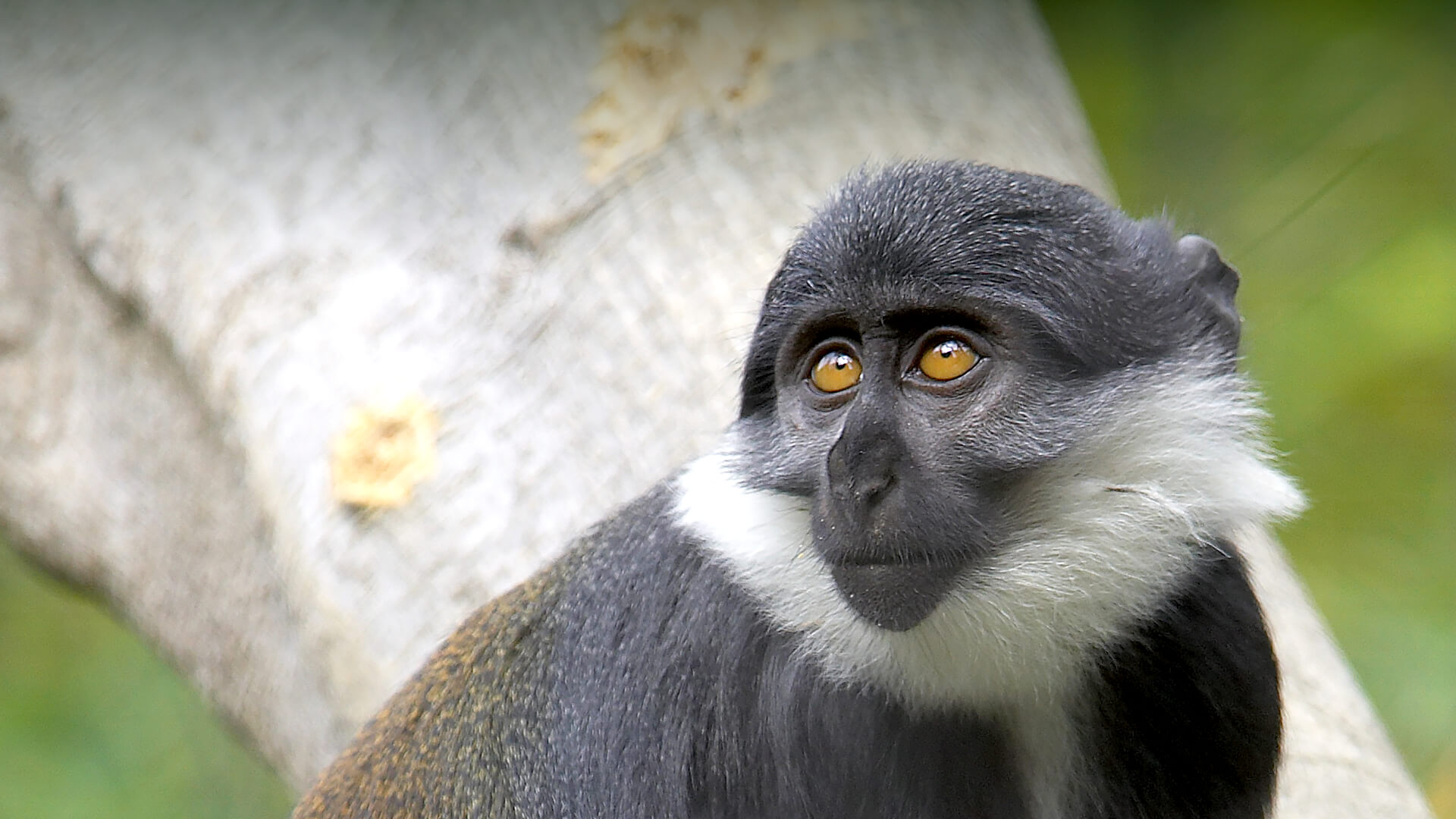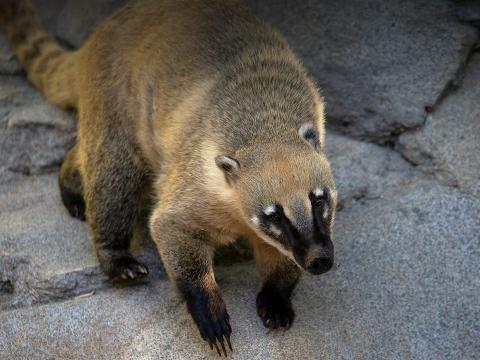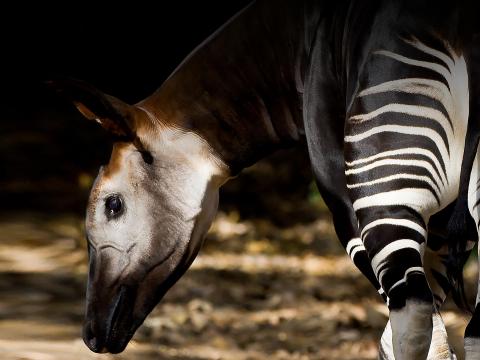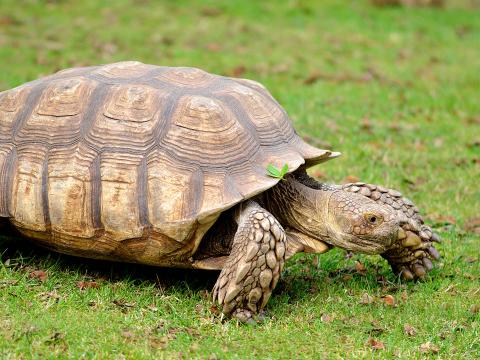Guenon
- CLASS: Mammalia (Mammals)
- ORDER: Primates
- FAMILY: Cercopithecidae
- GENERA: 6
- SPECIES: 36
ABOUT
Cheeky fellows: Guenon (GWEN non) is the name for a group of medium-sized monkeys that have long back legs, a rounded head, a long tail that helps them balance while moving through the trees, and large cheek pouches. The word guenon comes from the French word for monkey. Monkeys in the guenon group are some of the most colorful, graceful, and lively in Africa.
Guenons are best known for their striking color patterns, such as hip stripes, brow bands, or a white nose spot or band. Facial adornments can also include a throat ruff, beard, or mustache. They use their cheek pouches to store extra food as they forage. The pouches can hold almost as much as their stomach can!
While guenons make a variety of sounds, they also communicate with several gestures and facial expressions: an open mouth showing sharp teeth, closed eyelids, or a movement of the head or tail can get different messages across to other guenons loud and clear! Yet, except for occasional grunts issued by the group leader to keep the troop together or to warn of potential danger, they are rather silent. Expressive tails, which are longer than the body, are used to indicate mood.
Spot-nosed and crowned monkeys also communicate by jerking their head in different positions, each of which mean something specific. De Brazza's monkeys use their lush, white beard for visual displays. Scientists have recorded seven different sounds Wolf's monkeys make, including a grunting call they use to keep in contact while foraging. It appears that this grunting increases when the Wolf’s monkeys are foraging for insects: could this be their favorite food?
Red-tailed monkey—friendly neighbors: Red-tailed monkeys have a white nose, a speckled, yellow-brown coat, and a long, chestnut-red tail. They can live in large groups of up to 50 monkeys, but when things get too crowded for the amount of food available, the troop may split into smaller groups.
Wolf's monkey—tufted ears and much to hear: These colorful guenons have nothing to do with a wolf: they were named after the person who first described them for science. They have a pale forehead and a black stripe above their eyes, stretching from tufted ear to tufted ear. This gives them a rather grim appearance, but they are social. Because they also feed on nectar, Wolf's monkeys serve as pollinators for certain rainforest trees.
Spot-nosed monkey—talking with tails: Furry white beards and a bright white mark on the nose make spot-nosed monkeys easy to identify. These energetic and curious guenons use their expressive tails to "talk" to others and indicate their mood.
De Brazza's monkey—colorful loners: A bit different from most other guenons, De Brazza’s monkeys are often paired for life. Among the largest of the guenons, De Brazza's have a distinctive, beautiful coloration. Their body is grayish, with a reddish-brown back and black arms, legs, and tail. Their rump is white, and they have a white stripe on their thighs. Young De Brazza's monkeys have a yellow rump, and adult males have a bright blue rump display during mating season! Groups of De Brazza's have been known to sit completely still for up to five hours and then creep silently away into the forest.
Allen's swamp monkey—go fish: Classified as a separate guenon species, Allen’s swamp monkeys “go fishing” by laying leaves or grass on top of the water, and grabbing fish that come to hide underneath. As their name implies, swamp monkeys live near water and are good swimmers; webbed toes help them paddle through water. They have been known to dive into the water to escape predators. Allen's swamp monkeys have a sturdy build and gray/green skin. The face is reddish with long hair bundles at the cheeks.
This monkey likes company! The average group size is around 40 individuals. These large groups are divided into sub-groups of two to six monkeys that work together foraging for food. The groups' sleeping sites are usually located near water, and become regular spots and repeatedly used.
HABITAT AND DIET
Guenons come from western and central Africa, were they live in different types of forests. Like many monkeys native to Africa and Asia, guenons have a pad of tough skin and underlying tissue that cushions their rear end for sitting. Most guenons are arboreal, living in the tropical forests and woodlands. But some spend a greater part of their time on the ground and are found in forested mountain areas.
Unlike other tree-dwelling and leaf-eating monkeys, guenons have a more varied diet that includes fruits, seeds, and insects. Guenons also prey on some reptiles and occasionally small mammals. Arboreal guenons travel down to the lower branches and sometimes even to the forest floor to find tasty bugs and leaves.
At the San Diego Zoo, the guenons eat nutritionally complete primate biscuits, assorted fruits (such as apples, grapes, melons), vegetables (green beans, corn, eggplant), and greens (cabbage, lettuce, kale). These items are rotated so the guenons have different selections each day.
FAMILY LIFE
Most guenons live in large groups of females and at least one resident male, with groups of "outsider" males drifting in and out of the territory. Sometimes males live separately or in small bachelor groups. Different guenons often mix together. They understand each other's alarm calls and know how to react.
Guenons use loud, booming calls and bird-like chirps to alert each other. The calls vary depending on the type of predator and its location. The alarm call for the lesser spot-nosed guenon sounds like a car purring; the male “purrs” to distract the threat while his troop quietly slips away. Danger for guenons can come from chimpanzees, leopards, or eagles. Hanging out with other kinds of monkeys may help all the monkeys improve their diets and be better able to spot predators—safety in numbers!
De Brazza's live in male/female pairs. They have a large "boom" call, made even louder when they inflate their vocal sac, which they use as a warning. The males shake branches to keep a predator away and may even attack!
Guenon mothers are the main caregivers for their single infant, although other adult females in the group may assist. Guenon babies are carried by the mother, and at two weeks of age, babies are able to climb on their own. They attain their adult coloration at two to three months; the characteristic beard and mustache of De Brazza’s monkeys appear at about three weeks. De Brazza’s monkey babies grow up faster than those of other guenons; by the time they’re five months old, they’re already finding and eating their own fruit.
Guenon babies are weaned at 9 to 18 months, depending on the species. With most guenons, related females stay with each other throughout their lives; a daughter’s social status depends on her mother’s ranking in the group. Males leave their family to join a different group when they reach maturity.
CONSERVATION
As logging roads open a way into the forests of equatorial Africa, guenons are one of the primary targets being hunted by humans for the illegal bushmeat trade. Often, guenon mothers are killed and their babies kept as pets. Dryad monkeys Cercopithecus dryas are at critical risk, the Preuss’s monkey Cercopithecus preussi is endangered, and others are vulnerable.
By supporting San Diego Zoo Wildlife Alliance, you are our ally in saving and protecting wildlife worldwide.










